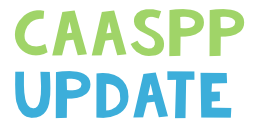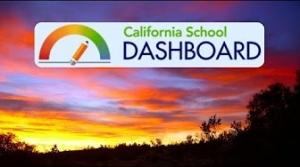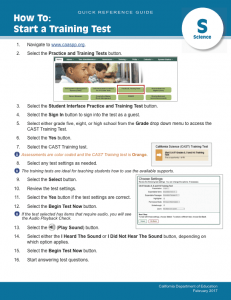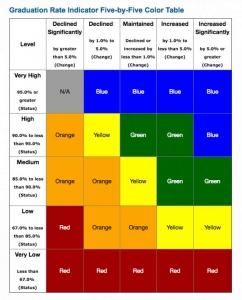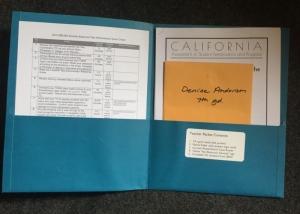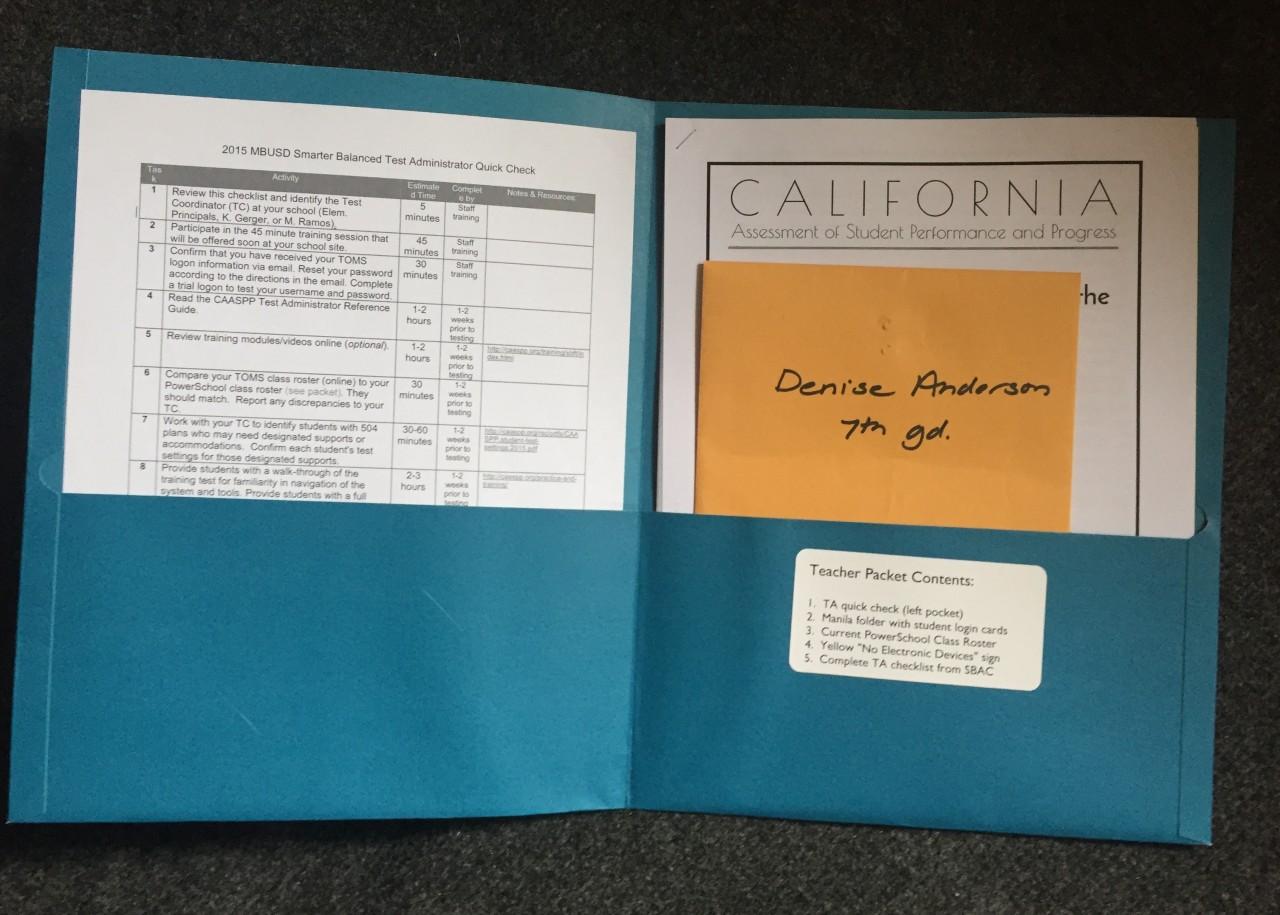Operational ELPAC Summative Assessment Administration and Scoring Trainings Begin Next Month! The ELPAC Summative Assessment (SA) Administration and Scoring Trainings will begin on October 24 and continue through December 13. LEA ELPAC Coordinators are responsible for registering participants from their LEA. Coordinators will receive an e-mail the first week of October confirming LEA participants' registration. That e-mail will include a registration code that the Coordinator can use to log on to the registration system at any time this fall and change participants' names as well as add names to the waiting list. Specific registration information is located on the ELPAC Web site, under the "...
The English Language Proficiency Assessments for California (ELPAC) Update, from the California Department of Education (CDE), is an e-mail for K–12 educators, including testing coordinators that focuses on the English Language Proficiency Assessments for California. When the ELPAC is operational, it will replace the California English Language Development Test (CELDT). The ELPAC Update will be sent once per month beginning March 2017. Please forward this e-mail to any educators in your local educational agency (LEA) who would be interested in or benefit from this information. Operational ELPAC Summative Assessment Administration and Scoring Training: Registration Now Open Thank you fo...
Postponement of Public Release of 2016–17 CAASPP Summary Results During the preview period of the 2016–17 CAASPP public Web reporting site, some local educational agencies (LEAs) identified a small number of cases in which test results did not appear to aggregate as expected to their district or charter school summaries. The CDE delayed the release of the statewide test results in order to investigate these reported cases. The issue impacts only the CAASPP public Web reporting site and the research files available from that site for 2016–17. Please be assured that the individual student achievement levels and scale scores that have been reported to your LEA or direct funded ...
Focusing on the California Assessment of Student Performance and Progress (CAASPP) System, including the Smarter Balanced assessments—a major component of CAASPP—and the California Alternate Assessments and science assessments. Accessibility Last month, the Smarter Balanced Assessment Consortium passed eight motions to update the Usability, Accessibility, and Accommodations Guidelines (UAAG). The changes, which apply only to specific CAASPP assessments, are as follows: New universal tools - Embedded thesaurus - Embedded line reader New designated supports - Non-embedded amplification - Embedded mouse pointer size and color New accommodations - Embedded braille transcript ...
The English Language Proficiency Assessments for California (ELPAC) Update, from the California Department of Education (CDE), is an e-mail for K-12 educators, including testing coordinators, which focuses on the English Language Proficiency Assessments for California. When the ELPAC is operational, it will replace the California English Language Development Test (CELDT). The ELPAC Update will be sent once per month beginning March 2017. Please forward this e-mail to any educators in your local educational agency (LEA) who would be interested in or benefit from this information. ELPAC Regulations Approved! Have you heard the news? The ELPAC regulations have been approved and will become effe...
The English Language Proficiency Assessments for California (ELPAC) Update, from the California Department of Education (CDE), is an e-mail for K–12 educators, including testing coordinators, which focuses on the English Language Proficiency Assessments for California. When the ELPAC is operational, it will replace the California English Language Development Test (CELDT). The ELPAC Update will be sent once per month beginning March 2017. Please forward this e-mail to any educators in your local educational agency (LEA) who would be interested in or benefit from this information. Superintendent's Designation of LEA ELPAC Coordinator Form Due August 1 Just a brief reminder: The Superintendent'...
Here's an even better video explaining how the new California School Dashboard works and what it replaces. (And why this system is likely a better, more holistic approach to evaluating school progress). The video was created by two educators from Brea Olinda USD, who gave me permission to link to the video here on the site. Thanks Kerry & Erin!
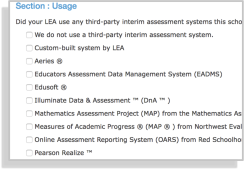
In my role as Director of Data & Assessment for Westchester Secondary Charter school I had the pleasure of supporting a research evaluation of the CAASPP/SBAC efforts underway in California. The Independent Evaluation Report was posted to CDE’s website today. You can find it at: http://www.cde.ca.gov/ta/tg/ca/caaspprptstudies.asp As an advocate for effective software systems and a participant in the study, I added my voice to the notion that the CDE should be looking much closer at existing 3rd party assessment systems. More than half of California's school districts have a 3rd party assessment system in place already, in ADDITION to the formative/summative resources available through CAASPP. The report explains in very understandable language the need to understand these 3rd party systems and the need to provide more integration resources to get data moving back and forth between systems. I also provided the investigative team with a list of known California assessment system providers. They incorporated that information into a survey (pictured above) which was distributed to school-site CAASPP coordinators (orange) and District CAASPP coordinators (blue). Though not a representative sample for state-wide assessment system adoption, it was interesting to see the results. Is the somewhat large discrepancies between what the schools are doing and what the districts are doing have any significance? Table source: http://www.cde.ca.gov/ta/tg/ca/caaspprptstudies.asp (Pages 45/46). A Note from Sunny Becker, one of the authors: This report includes results of our two 2016 studies: the CAASPP Smarter Balanced Interim Assessment Administration Study and the Access to Designated Supports and Accommodations Study. Many thanks to the representatives of Corona-Norco Unified, Fresno County Office of Education, Greenfield Union, Learning for Life Charter, Los Angeles Unified, Oakland Unified, Poway Unified, Salinas Union High, San Diego Unified, Tulare City, Victor Valley Union High, and Westchester Secondary Charter, who participated in one or both of these studies! Hooray Westchester Charter for helping to advance the assessment system conversation. Woot-woot!
March 20, 2017 Dear County and District Superintendents and Charter School Administrators: LAUNCH OF THE PILOT TESTS FOR SCIENCE The California Department of Education (CDE) is pleased to announce the launch of two new assessments for pilot testing, the California Science Test (CAST) and the California Alternate Assessment (CAA) for Science. These assessments will be available once your local educational agency (LEA) testing windows opens. Please note that students and schools will not receive results from the CAST and CAA for Science pilot tests. I encourage you to use this opportunity to begin the transition to the California Next Generation Science Standards (CA NGSS).&n...
CAASPP Update Focusing on the California Assessment of Student Performance and Progress (CAASPP) System, including the Smarter Balanced assessments—a major component of CAASPP—and the California Alternate Assessments and science assessments. Accessibility Notes: Updated Guide Now Available! The updated Accessibility Guide for CAASPP Online Testing , which includes a change log (in the appendix), is now available on both the Student Accessibility Resources and Test Settings Web page and the Manuals and Instructions Web page of the CAASP Portal Web site. March System Downtime Begins Tonight Tonight at 5 p.m. through March 20 at 7 a.m., the Test Operations Management System, Test Administrator Interface, Interim Assessment (IA) Viewer, IA Hand Scoring, Online Reporting System, and the Appeal, Completion Status, and Roster Management systems will be undergoing system maintenance and will not be accessible. March 20—California Alternate Assessments and California Science Tests March 20—the opening of the CAASPP science and alternate assessments administration—is less than a week away! Are you ready? The high school grade-level assignment for the pilot California Science Test (CAST) and the pilot California Alternate Assessment (CAA) for Science can be confirmed by checking the assignment link on the CAASPP Portal CAST Web page . Confirm your CAA version assignments before you start printing out Directions for Administration (DFAs) or administer the CAA for English Language Arts and CAA for Mathematics. The new CAA for Science pilot test is a performance task (PT) assessment designed to be administered closer to the student’s instructional activity. This innovative assessment allows test examiners (TEs) some flexibility in the administration of the PT. TEs can select familiar materials for students and allow students to demonstrate what they know. A sample training test is available on the CAASPP Portal CAAs Web page . The training test is aligned with the grade five California Next Generation Science Standards but can be used by students in any of the tested grades to familiarize educators, students, parents, and stakeholders with the testing format of the pilot. This training test is the same type of embedded PT that will be administered during this year’s pilot CAA for Science. Designed to be administered one on one, the training test PT is nonsecure and for use in preparing for the pilot CAA for Science. Science Fact Sheets The California Science Test Pilot Assessment Fact Sheet is now available! It provides a quick and easy “Who, What, When, Why, and How” for the CAST as well as a timeline for implementation through to the operational assessment in 2019. A fact sheet for the California Alternate Assessment for Science will be posted soon. Please share this e-mail with any educators in your local educational agency who would be interested in or benefit from this information. To join the e-mail list, send a blank e-mail message to
Dear Accountability Coordinators: March 13, 2017 INFORMATION REGARDING THE UPDATED DATA FILES FOR THE DASHBOARD AND 5-BY-5 GRID PLACEMENT REPORTS On Wednesday, March 8, 2017, an e-mail was sent notifying that updates were made to: (1) the data files for the Suspension, Graduation, and English Learner Progress Indicators, (2) the California School Dashboard, and (3) the Five-by-Five Placement Reports. This is a follow-up to that communication to inform you of the specific revisions made and to notify you that the Academic Indicator will be updated by the end of the day. The specific updates are as follows: Suspension Rate Indicator: The local educational agency (LEA)-level data now exclude charter and alternative schools’ data. Prior to the update, the LEA-level data included these schools’ data. This update impacted most LEAs’ suspension rate data. Graduation Rate Indicator: The LEA-level data now exclude all alternative schools’ data. Prior to the update, only Alternative Schools Accountability Model (ASAM) schools’ data were excluded. The revisions now exclude both ASAM schools’ data and schools that meet the alternative school definition in the California Education Code (EC) (i.e., continuation, community day, opportunity, juvenile court, county community, etc.). This update impacted a limited number of LEAs only. English Learner Progress Indicator: Prior to the update, LEAs and schools received an automatic assignment of an Orange performance level if they did not test at least 50 percent of their annual California English Language Development Test (CELDT) test takers. The calculation of the 50 percent has been revised to include all CELDT test takers, not just annual test takers. This update reduced the number of schools that were assigned the Orange performance level. (There are no LEAs that received an assignment of an Orange performance level.) Academic Indicator:Determining the N size of “30 or more” for the Students with Disabilities (SWD) student group has been revised to be based only on students who have a valid primary disability code in the California Longitudinal Pupil Achievement Data System (CALPADS). Therefore, the SWD student group will receive a performance level (color) if the group has 30 or more students with a valid primary disability code in both the current and prior years of data. However, this student group also includes students who exited special education and have not received special education services for up to two years. These students are not used to determine the “30 or more” N size. But, both current and exited SWDs are included in the calculation for Status and Change. For example, a school that has 28 students with a valid primary disability code and two students who exited special education within the past two years would not receive a performance level because students with a valid primary disability code is less than 30. Because the N size is above ten, Status and Change will be reported based on all 30 students. This update reduced the number of SWD student groups that receive a performance level. If you have any questions regarding this e-mail, please contact the Academic...
What are the Smarter Balanced Assessments? The Smarter Balanced assessments are a series of tests taken by students in 17 states, including California. The tests are administered to students only in grades 3, 4, 5, 6, 7, 8, and 11. Students in other grades are not assessed by Smarter Balanced. The tests themselves are different from traditional tests in that the students complete them using a computer. Schools provide appropriate laptop, "chromebooks" or traditional desktop computers securely connected to the Internet, to complete each test. Students must TYPE their open ended and essay responses, and use the mouse or trackpad to select other responses and move from question to question. Test #1 Math Computer Adaptive Test Each student takes a total of FOUR individual tests. The first is a Math test of approximately 35 to 50 questions that requires students to identify the correct answers from pre-determined answers, enter their own "open-ended" responses with no answer prompts, and complete matching activities. This is called a "Computer Adaptive Test" because the test is supposed to respond to how well the student is doing, and adjust the difficulty level of the questions accordingly. As a result, some students may complete only 35 questions, while others may complete as many as 50 individual questions. Some students may finish in 60 minutes, while others take 90 minutes or even longer. Since there is no pre-determined time limit, some students may even take 3 or 4 hours to complete each test! (This creates a set of new challenges for teachers and administrators, who must now accomodate longer testing periods with the additional hurdles of having reliable internet networks and sufficient computer equipment.) Most, but not all, of the CAT test is graded by the computer. Only the "open-ended" responses on this test require a teacher to evaluate and score, and this is done by the publisher of the test, the Educational Testing Service. So it is very unlikely that your student will be evaluated by his or her own teacher. Test #2 Math Performance Task The second test, also in Mathematics, is a so-called "Performance test." This test, like the three others, is also conducted online using a computer. Unlike the Computer Adaptive Test or "CAT" test, however, the Performance test or (PT) is characterized by a longer, more complex problem or activity that involves a number of different standards and ideas. Students give essay-type responses of varying length, and usually answer between 3 and 8 questions. Despite the smaller nubmer of questions, the PT takes just as long, or longer, for the students to complete. All of the PT tests Each Performance Task is preceded by a short, teacher-led, classroom lesson. This "mini-lesson" is designed to provide a "level playing field" for students. This activity helps students who might not be familiar with the specific subject matter being discussed, or English language learners or students with special needs. The mini-lesson is usually taught by the student's own classroom teacher, though if the...
Golden State vs. the Feds! - Or, How Best to Reconcile the LCFF/LCAP Stuff with the New Federal Regulations. The State Superintendent of Public Instruction (SSPI) and the State Board of Education (SBE) President Michael Kirst jointly signed a letter in response to the proposed regulations for ESSA accountability, data reporting, and submission of state plans, detailing concerns about the proposed regulations and making recommendations to address those concerns. The letter was submitted through the Federal Register on August 1 and may be viewed on the CDE Response to ESSA Proposed Regulations Web page. The new ESSA regulations are chalk full of new requirements for state data report...
CAASPP Update # 161 - July 6, 2016 Focusing on the CAASPP System, including the Smarter Balanced assessments—a major component of CAASPP—and the California Alternate Assessments and science assessments. Updated Usability, Accessibility, and Accommodations Guidelines The Usability, Accessibility, and Accommodations Guidelines document has been updated for the 2016–17 CAASPP administration. Among the changes are two new resources: - Simplified Test Directions (non-embedded designated support) - 100s Number Table (non-embedded accommodation) In addition, the recommendations on the use of scratch paper (non-embedded universal tool) now include the use of a whiteboard and marker as well as low-te...
A Weekly E-Mail from the California Department of Education
CAASPP Update
Focusing on the CAASPP System, including the Smarter Balanced assessments—a major component of CAASPP—and the California Alternate Assessments and science assessments.
Summer Hand Scoring Workshops Online Registration Coming Soon!
Educational Testing Service (ETS) will conduct one-day CAASPP Summer Hand Scoring Workshops in July and August. These workshops will train educators to score constructed-response items and performance tasks for English language arts/literacy and mathematics and to prepare students for the Smarter Balanced Summative Assessments.
The workshops, which will take place from 8:30 a.m. to 4:30 p.m., are scheduled as follows:
Issue 158
June 15, 2016
A Weekly E-Mail from the California Department of Education
CAASPP Update
Focusing on the California Assessment of Student Performance and Progress (CAASPP) System, including the Smarter Balanced assessments—a major component of CAASPP—and the California Alternate Assessments and science assessments.
Revised CAASPP Regulations Now Available
On May 18, 2016, the Office of Administrative Law approved California Code of Regulations for CAASPP. The CAASPP regulations are located on the California Department of Education (CDE) CAASPP System Web page under the “CAASPP Info” tab. Highlights of the revisions made to the CAASPP regulations include the following:
Section 851.5(c) clarifies eligibility for the Standards-based Tests in Spanish as a student in one of grades three through eight and grade eleven (1) whose primary language is Spanish and who is receiving instruction in Spanish; or (2) who is enrolled in a dual language immersion program that includes Spanish; or (3) who is a recently arrived English learner and whose primary language is Spanish.
Shasta COE data dashboard reachhighershasta.com
Butte COE LCAP resources bcoe.org
Math Performance Tasks map.mathshell.org
Science Performance Tasks nextgenscience.org
Literacy Design Collaborative ldc.org
Better Lessons betterlesson.com/master_teacher_projects
Curriculum Review Reports edreports.org
Accessibility Notes: Multiplication Table Please note the following information about the Multiplication Table (PDF) External link opens in new window or tab., available through the CAASPP Portal External link opens in new window or tab It is a non-embedded accommodation available to students in grades four and above who have an individualized education program or Section 504 plan. For students in grade three who have a documented need, it must be requested as an unlisted resource in TOMS. The use of the multiplication table in grade three can be found in Matrix One: Universal Tools, Designated Supports, and Accommodations for the California Assessment of Student Performance and P...
Smarter Balanced Content Development Opportunities This Summer! If you are a California educator with the following qualifications, Smarter Balanced wants to hear from you regarding possible participation in content development activities: l Currently certified or licensed to teach English language arts/literacy (ELA) and/or mathematics in a K–12 public school or certified to teach English learners and/or students with disabilities.Currently teaching in a public school or currently employed by a public school, district, or state education entity, including higher education, located within a Smarter Balanced member state.Within the past three years:Have taught ELA and/or mathematics in grades three through eight and/or high school or worked in a classroom content support role, such as a literacy or mathematics coach or district/state content specialist.and/or Have taught students with disabilities and/or English learners in grades three through eight and/or high school or worked in a support role, such as a district/school coordinator or instructional specialist. Educators with specialization in teaching students with visual impairments or who are deaf or hard of hearing are encouraged to apply.Familiarity with part or all of the Common Core State Standards for the content area in which they are interested in working. For ELA item review, educators who have documented expertise in the area of science and/or social science may apply.Some opportunities will have additional preferred experience qualifications. The activities are taking place this summer, beginning in July, and selected educators will participate in a meeting that lasts four or five days. The content development meetings are as follows: Data review—review of field-tested items for possible content-related issues or accessibility-related issuesItem review—review of items before their being field-testedInterim assessment block/Digital Library connections—development of resources to connect the Digital Library with interim assessment blocks Apply by e-mailing Dixie Abbott, California Educator Involvement Coordinator,
To help teachers administer the Smarter Balanced CAASPP tests we made each teacher an info packet. Inside each packet we put a one-page summary of the steps they needed to take to become familiar with the test, learn how to administer it online, and provide the necessary signs and student ID cards. Basically we tried to make it as simple as possible. We included a one-page "quick check" since we knew they probably wouldn't read the whole 50 page manual :). We also printed out a "login ticket" for each student with their first name, SSID#, and class schedule (helpful when conducting make-ups). We included a class roster, signs, and other helpful items.


